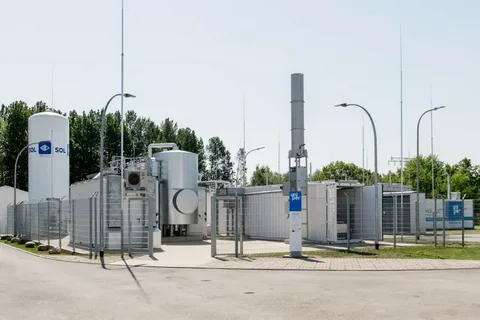Renewable Integration and Decarbonization with Power to Gas Technology

Introduction
The Power to Gas (P2G) Market is emerging as a crucial technology in the global energy transition landscape, bridging the gap between renewable electricity generation and gaseous fuel storage. P2G technology converts surplus electricity, primarily from renewable sources such as wind and solar, into hydrogen or synthetic methane through electrolysis and methanation processes. These gases can then be injected into existing natural gas networks or used in industrial applications, mobility, and power generation. With the rising emphasis on decarbonization, energy storage, and sector coupling, P2G is increasingly recognized as a strategic solution to manage intermittent renewable energy while reducing greenhouse gas emissions. The market is gaining traction as countries worldwide aim to achieve net-zero emissions and integrate flexible energy solutions across sectors.
Market Drivers
The P2G market is driven by the growing need for large-scale energy storage solutions that can support variable renewable energy sources. Governments’ commitments to net-zero targets, climate policies, and renewable energy mandates are significantly boosting investments in P2G technologies. The rising adoption of hydrogen as a clean fuel in industries, transportation, and power generation also fuels market growth. Furthermore, the ability of P2G systems to stabilize power grids by balancing electricity supply and demand provides an additional impetus for adoption. Increasing funding for research and development of high-efficiency electrolysis technologies and the deployment of pilot projects worldwide are contributing to market expansion.
Market Challenges
Despite the promising outlook, several challenges limit widespread adoption. High capital costs for electrolysis and methanation equipment remain a primary barrier. The low efficiency of conversion processes compared to direct electricity usage and the need for continuous renewable electricity input can affect operational feasibility. Infrastructure limitations, such as the integration of hydrogen or synthetic methane into existing gas networks, pose logistical and regulatory challenges. Moreover, the market faces competition from alternative storage solutions like batteries and pumped hydro storage, which may offer lower upfront costs. Policy uncertainty and variations in government incentives across regions further complicate market growth.
Market Opportunities
Significant opportunities exist for P2G in supporting decarbonization across multiple sectors. Hydrogen produced via P2G can be utilized in industrial processes, heavy-duty transport, and power generation, creating cross-sector applications. The growing adoption of carbon-neutral synthetic fuels in Europe and Asia is expected to expand demand for P2G solutions. Integration with smart grids, renewable energy plants, and energy storage systems offers potential for higher efficiency and optimized operations. Emerging regions with abundant renewable resources, such as the Middle East, Africa, and Latin America, present untapped market potential. Continuous innovation in electrolysis technologies, including proton exchange membrane (PEM) and solid oxide electrolysis, is improving conversion efficiency, further boosting market prospects.
Regional Insights
Europe currently leads the P2G market, driven by strong government policies, renewable energy integration, and advanced energy infrastructure. Germany, the Netherlands, and Denmark are at the forefront of pilot projects and large-scale P2G deployments. Asia-Pacific is witnessing rapid growth, with countries like Japan, South Korea, and China investing in hydrogen infrastructure and renewable energy to reduce fossil fuel dependency. North America, led by the United States, is gradually adopting P2G technology, particularly in regions with high wind and solar capacity. The Middle East and Africa are exploring P2G as part of long-term clean energy strategies, leveraging abundant solar resources to produce green hydrogen. Latin America’s renewable energy expansion, especially in wind and solar, is creating emerging opportunities for P2G integration.
Future Outlook
The Power to Gas market is expected to grow substantially in the coming decade as global energy systems increasingly transition toward decarbonization and renewable integration. Technological advancements in electrolysis efficiency, cost reductions, and scaling of synthetic methane production are anticipated to enhance the economic viability of P2G solutions. Policy support, carbon pricing, and renewable energy incentives will further drive market adoption. Additionally, the convergence of P2G with other energy storage and conversion technologies, such as fuel cells and hydrogen pipelines, will create integrated solutions for sustainable energy management. The future market will likely witness collaborations between energy providers, industrial users, and governments to deploy large-scale P2G projects that contribute to a resilient, carbon-neutral energy ecosystem.
Conclusion
The Power to Gas Market represents a transformative approach to energy storage and decarbonization, leveraging renewable electricity to produce hydrogen and synthetic fuels for multiple applications. Despite challenges such as high costs and infrastructure requirements, the market is poised for significant growth, driven by policy support, technological innovation, and the rising need for flexible and sustainable energy solutions. As countries focus on achieving net-zero emissions and energy system resilience, P2G technology will become an integral component of future energy infrastructures.
- Art
- Education et Formation
- Crafts
- Sciences et Technologies
- Economie
- Politique
- Actualité
- Littérature
- Divertissement
- Histoire
- Health
- Actualité
- Shopping & Commerce
- Music
- Agriculture & élevage
- Voyage et Evènementiel
- Beauté & esthétique
- Religion
- Festival
- Sports
- Fête
- Autres



